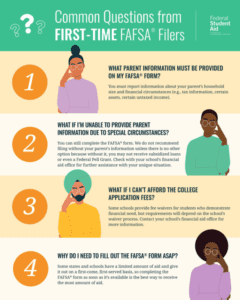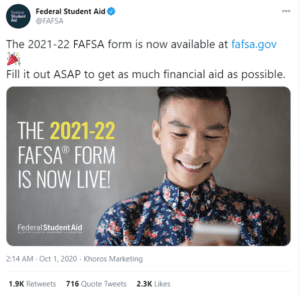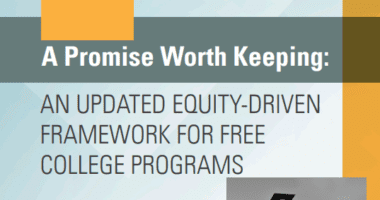Equity Edition: COVID-19 Crisis Leaves Many Families with Greater Need for College Financial Aid Assistance
Equity Edition: COVID-19 Crisis Leaves Many Families with Greater Need for College Financial Aid Assistance
Awareness efforts across state seek to inform students about financial aid
By Riley Stone, data and policy analyst at the Education Trust-Midwest
The COVID-19 health and economic crisis has disrupted financial stability for many families, leaving many college-age children with increasingly urgent needs for financial assistance to pay for their postsecondary education.
That makes it especially important for families to submit a Free Application for Federal Student Aid (FAFSA). An analysis by NerdWallet estimates the high school graduates in 2018 that didn’t complete a FAFSA left roughly $2.6 billion unclaimed.
College affordability has long been a challenge for Michigan’s students. On average, a low-income Michigan student paying in-state tuition at a four-year public institution, who lives on campus and works over the summer, faces a $1,659 affordability gap. This means that despite financial aid and summer wages, a low-income student still falls $1,659 short, on average, of being able to afford Michigan’s four-year public institutions.
The Education Trust-Midwest’s 2020 annual report, “A Marshall Plan: Reimagining Public Education,” outlines recommendations for state leaders to ensure Michigan students are both academically prepared for postsecondary education and able to afford it, especially those who are already underserved.
“Our ultimate goal is to remove barriers for accessing financial aid by ensuring every high school graduate either submits a FAFSA or knowingly opts out of completing the form—a goal that is especially important as students and families manage an economic downturn,” said Mary Grech, senior data and policy analyst for ETM. 
Grech noted recent progress towards making information about financial aid opportunities more accessible to Michigan students and families. For instance, the FY21 budget passed by Governor Whitmer on September 30 calls on the department of treasury to launch a campaign to inform high school students about state financial aid programs and eligibility requirements. Furthermore, a partnership between the department of treasury, Michigan College Access Network and other postsecondary associations will provide an online informational resource for student loan borrowers.
The website will inform students about:
- A list of community support centers, debt clinics and other organizations that provide free information and services for student loan borrowers;
- A list of loan servicers;
- Information on the benefits of federal student loans that may become unavailable if loans are refinanced;
- Links to financial aid programs including the FAFSA and College Scorecard;
- Information on the fundamentals of borrowing and repayment.
Other important steps to informing families about college aid opportunities include the Michigan Department of Education’s partnership with the College Board on their Opportunity Scholarships program. The program provides a six-step guide for planning, preparing and paying for college while offering chances at scholarships of $500 or more along the way. At least half of the scholarships will be designated for low-income students (students whose families earn less than $60,000 per year). In one step, submitting the FAFSA can earn students a chance at a $1,000 scholarship.
Recently considered legislation in the Michigan House of Representatives, House Bill 6171 and 6172, would help address the impacts of COVID-19 on students who may benefit from Michigan financial aid programs. House Bill 6171 addresses financial challenges by temporarily extending the period that eligible students have for using tuition grants for up to two additional semesters, if they are currently enrolled and were enrolled last spring. Another educational impact of the pandemic last spring was the cancellation of year-end assessments, including the SAT. Under House Bill 6172, scholastic achievement may be used to temporarily replace the Michigan Competitive Scholarship eligibility requirement that is usually satisfied by SAT score for scholarship award eligibility during the 2020-2021 school year.
“For high school students who are preparing to enter postsecondary education, disruptions to learning due to COVID-19 can be particularly harmful—and expensive,” Grech said. “It is our hope that these state partnerships coupled with statewide advocacy will help Michigan students be aware of the opportunities for aid and assistance available to them so they are well-positioned to succeed in the 21st century global economy.”
Students and parents can access the form online at FAFSA.gov on a desktop or mobile device.
The Free Application for Federal Student Aid (FAFSA) for 2021-2022 launched on October 1. The FAFSA is a common application used for determining eligibility for public financial aid, as well as many institutional and private scholarships and grants. Federal officials and college experts recommend that new and returning students who plan to attend college between July 1, 2021 and June 30, 2022 should submit the FAFSA as soon as possible.
Noteworthy News
- Students Could Have Lost as Much as 183 Days of Learning Time in Reading, 232 Days in Math During First Four Months of Largely Virtual Schooling, Linda Jacobson, The 74
- Michigan reports 26 new outbreaks at schools, universities, Jennifer Chambers, The Detroit News
- Here’s What the Stalled COVID-19 Aid Plans Would Do for Schools, Education Week





